Vertebrates are animals that have backbones and are the ones most familiar to everyone. They include the fish, amphibians, reptiles, birds, and mammals. But there are a couple of creatures that are not truly vertebrates but are not truly invertebrates either.

The development of the backbone on the embryo begins with a flat disk they call the neural plate. This folds over like a burrito to form what is called the neural tube. The anterior end of this tube forms three swellings which will become the brain. The posterior end of the tube becomes the notochord. This is basically an endocrine gland that secretes hormones. The lower portion of the notochord eventually gives rise to the vertebral column, or what we call the backbone. In some vertebrates the notochord retracts like the tail of a tadpole. In others it remains. All creatures who form notochords are placed in the same phylum – Chordata. But three creatures never develop the true backbone, only the notochord. These are called the protochordates (“before backbone”).

Image: Wikipedia.
They each have their own subphylum name. So, under the phylum Chordata there is…
Subphylum Hemichordata. These are known as acorn worms. They are basically bottom dwellers that feed on organic debris. Most burrow in the sediments but a few can live on the sediment and sometimes rise into the water column to drift to new feeding locations. Most are very small, but some may reach lengths of eight feet. Most live in the deep sea.
Subphylum Urochordata are known as the sea squirts or tunicates. These creatures begin life looking like worms or tadpoles and, at this stage, have a notochord. They eventually develop into a barrel shaped creature that resembles, and behaves, like a sponge. At this stage the notochord is retracted like the tail of a tadpole and no vertebral column forms. They are usually attached to structures like pier pilings in clusters. They have two siphons they use to filter water for plankton. When removed they will squirt water from these siphons – hence the name “sea squirts”. They are quite common along our beaches.
Subphylum Cephalochordata are known as amphioxus or lancelets. These are eel looking creatures that possess cirri, or thick hairs, around their mouths to feed on plankton. They are small and often bury into the service of the sediment with their heads exposed feeding. Their distribution is somewhat spread out but are in high numbers when found.
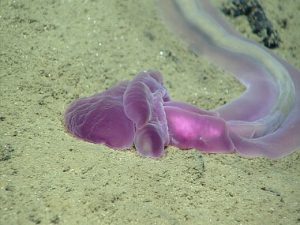
Photo: NOAA
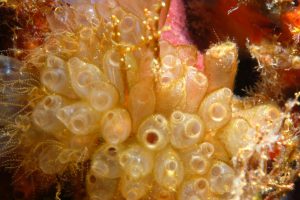
Photo: NOAA
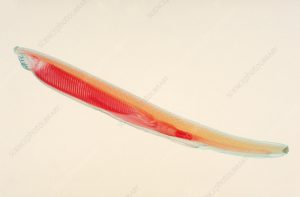
Then there is the Subphylum Vertebrata which include seven classes. Three of those are fish, and they are the topic of this lesson.
As a group, fish can be defined as vertebrates that possess scales, gills, and fins, and there is a large variety of them – about 30,000 species – making them the largest class of vertebrates. This would make sense in one way. They like water, and there is a LOT of it on this planet. The vast majority of that water is salt water, so there are many species of marine fish. But we all know there is a great variety of freshwater fish as well. Some fish can live in both fresh and seawater. They have high tolerance for salinity changes are called euryhaline fish. Most species prefer one or the other. Their tolerance for salinity is very low and are called stenohaline.
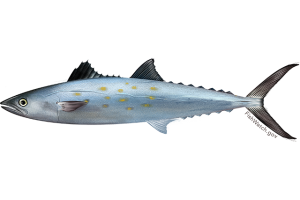
Image: NOAA
Either way, fish are aquatic creatures… well… most of them. There are some species that can live for periods of time on the beach. The mudskipper of Southeast Asia and the Walking Catfish of Africa both come to mind. Then there are the flying fish of the open ocean. These actually use modified pectoral fins to glide – they are not true fliers. And in the tropical parts of South American and Africa there are what are called lung fish who use a modified swim bladder as a lung and can breath air while buried in the mud of a dried up pond waiting for the monsoon rains to return. Then there are species who use the spines on their fins to walk on the seafloor. There are fish who can inflate like a balloon, change colors like a chameleon, and produce luminescent lights. There are some who swim all of their lives rarely, if ever stopping, and others who move very little. There are some who live in large schools moving in unison as one creature, and others that drift like large pieces of wood at the surface. There is truly a great variety of these creatures all over the planet and those who study them are known as ichthyologists. For this lesson, let’s look at the basics.
Anatomy.
The basic anatomy of a fish has a streamlined body (called fusiform) that is efficient for swimming. There are paired fins along this body. Those along the dorsal side (top) are called dorsal fins, and some fish may have as many as three. Those along the ventral side (bottom) are called ventral fins. The ventral fins close to the gill slit are called pelvic fins (they are close to the pelvis of the fish). The ones beyond the anus are called the anal fins. The fin that extends from the side of the body are called the pectoral fins (in the pectoral position) and the tail is actually a fin… not a true tail as found in cats and dogs, and so is called a caudal fin.

Image: University of Florida
Internally the fish is mostly muscle. Those who swim a lot have large amounts of myoglobin in addition to hemoglobin, which is very efficient at absorbing oxygen from the water and are called red muscle fish – tunas for example. Fish with white muscle tend to swim slower, stop, and explode on potential prey. Fish have seven gills on each side of the head, a heart, a digestive tract, but for most the largest organ is a sac called the swim bladder. This sac can be filled with gas and allow the fish to float in the middle of the water column at rest. In order for the gills to work, water must be flowing over them. When fish are stopped/floating they use a buccal pump to pump water over their gills. You can see them doing this as they open their mouths and then their gills. Some fish lack this pump and those must move forward to breath. We call these ram-jetters.
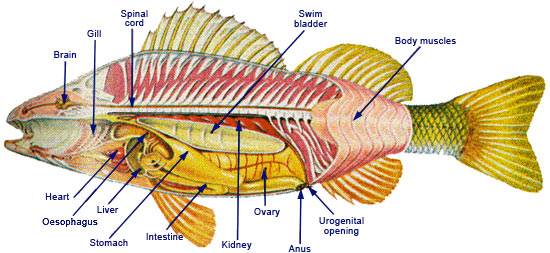
Image: Mesa.edu
Classification.
There are three classes of fishes. By the way the word “fish” is used for the plural of one species of fish. Fishes is used when there are many species of fishes.
Class Agnatha are fish that lack both bone and true jaws. Their skeleton is made of a more gelatinous form of bone called cartilage. They have seven gill pouches along the side of their head, one for each gill. This group does not have paired fins. They have multiple rows of sharp teeth, but they are imbedded into their lips and so cannot bite the way most fish could. One group, the hagfish, will seek out dead creatures on the seafloor (carrion). They will work their way into the carcass and, as the animal decomposes, consume the soft flesh. Their cousins, the lamprey, take another approach. They latch onto the side of larger fish with the outside row of sharp teeth and dig a hole in the side of the fish to consume body fluids of their prey – they are parasites. There are about 100 species in this group.
Class Chondrichthyes are fish that lack a bony skeleton, but they do have their teeth in jaws. These are the sharks and the rays. One, the seven gilled shark, has seven gill slits instead of gill pouches. Another, the six gilled shark, only has six gill slits – but still has seven gills. Most have five gill slits. You probably already know about these creatures from numerous nature programs on them. There are about 350 species in the group, most being sharks. Most sharks have sleek bodies for efficient swimming and an excellent sensory system for hunting prey. But not all sharks are carnivores. Some feed on carrion and one is a plankton feeder. Rays are basically flattened sharks. Their gills slits are on the underside (ventral) of the body and their pectoral fins begin before the gill slits do (opposite in sharks). They are famous for their stinging barbs, but actually only a few members of the group can do this.
Class Osteichthyes are the bony fishes. There are at least 20,000 members of this group and they come in all shapes and sizes. They true bone and jaws for their teeth. They also only possess one gill slit.
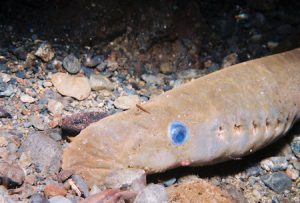
Photo: NOAA
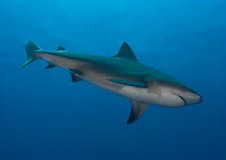
Photo: University of Florida
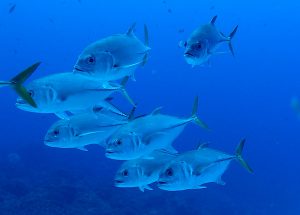
Photo: NOAA
Perception
Fish have the same five senses you and I do, and some have a sixth one – electricity. We all produce weak electric fields when we move our muscles. We cannot detect these electric pulses, but some fish can – and this is how they find their prey in murky waters or buried beneath the sand. Sharks and rays are famous for this. By adjustments to specialized muscles, some fish can produce an electric field which can be used to navigate in murky waters. And a few can generate an electric shock to kill their prey. There are species of rays that can do this but the most famous is the electric eel of the Amazon, who can produce over 600 volts.
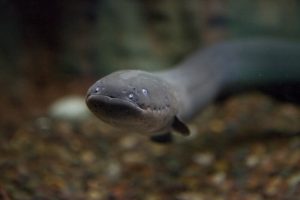
Photo: University of South Florida
Vision is our most important sense but, in a world, where light does not travel very far, it is not as important to most fish. Their eyes are set on the sides of their heads where they can seed ahead and behind them, but with this monocular vision comes the loss of depth perception. They may see you, but they may not know how far away you are. And this can be important information! To solve that problem, they will use their other senses to help out. One group of fish, the flounder and soles, have solved this problem by moving one eye over to the other side of the head. Having both eyes on one side of the head they will lay on their sides and use both eyes together, as we do, for better depth perception.
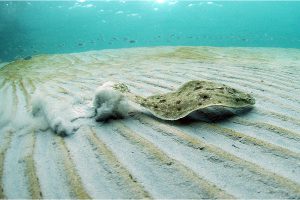
Photo: NOAA
Chemoreception (smell and taste) is very important to fish. Again, with the lack of light but an abundance of “odors” in the water, detecting these is very important. Some species of sharks are famous for their ability to detect small amounts of blood in gallons of seawater at great distances. This is an important point though. Chemoreception only works when the fish can smell/taste the chemical in the water. So, the fish must be “downstream” of the source to know it is there. But if they are downstream, they will sense it. If it smells like food, they will come. Cut bait does wonders attracting certain kinds of fish.
The sense of “touch” or is what drives a special fish organ called the lateral line. This is a line along the side of the fish, often visible, that possess small sacs filled with gel that detect pressure waves in the water. Changes in this pressure is what is used by fish when trying to school. When one moves because they sense something ahead, the entire school detects pressure changes of the movement from each other and the school turns in unison. This would also be connected to the sense of sound. Sound, unlike smell, can be detected from any direction. You do not have to be downstream of the sound to hear it. This is probably one of the most important senses used by sharks in detecting food. Sharks can detect changes in sound/pressure as far away as a mile. These changes can either attract or repel them. Many fishes, grunts and croakers for example, produce sounds to communicate in some way. They make these sounds by using muscles along the side of their swim bladders. You can hear this sometimes after you have caught one. The ocean is a NOISY place!
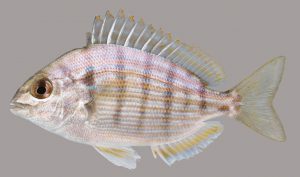
Photo: University of Florida
Thermoregulation
Body temperature is important for all vertebrates. There is a thermal range for which we can exist. We know that the freezing point of water is 32°F and that it boils at 212°F. We certainly do not want to reach those temperatures because of our bodies are made of water. So, there is a range between these two where we can exist. For most vertebrates, you want to be closer to the high temperature, what we called the thermal maximum. For humans our thermal max is around 105°F. If our temperature goes above 99°F we are said to have a “fever” and we feel REALLY bad… sick. At 105°F we are pushing death and need to get our body temperatures down. Our thermal minimum is said to be around 95°F. So, our temperature range is not much. We are considered endothermic (warm blooded) and can generate our own internal body temperature. Fish on the other hand are considered ectothermic (cold blooded) and regulate their internal temperature by moving to different environments. Most ectotherms have a wider temperature range than endotherms. If their body temperature drops to the 80s 70s or even 60s, they are fine. However, at these temperatures, they are slow and lethargic. This could be a problem if an endothermic predator (like a dolphin) is in the area. So, behavior changes usually go along with temperature changes in fish. When it gets really cold, they do one of two things – (1) migrate to warmer waters, or (2) hibernate. True hibernation is the slowing of the heart and breathing rate, along with the lowering of the body temperature, to a point where they may “appear” dead. But they are not. They are in what we call torpor or a “sleep” stage. If found in this stage they can be easily consumed because their metabolism is functioning so low, they may not be able to respond. So, they usually will find a “hiding” place to do this.
Some fish, ice fish, can exist below 32°F. The water in their cells does not freeze because they produce a sort of “anti-freeze” in their blood to keep this from happening. They will get very cold and solid, but they are not dead and will “thaw” in the spring.
Some fish have what is called a countercurrent system where they can direct the flow of blood away from their sides of their body and their fins. Keeping the blood close to the internal part of their bodies they can keep the temperature higher and live in pretty cold water – white sharks for example. Since there are controlling the internal blood flow, some biologists suggest they are controlling their internal temperature and are, in a sense, endothermic. Endotherms who can do this but adjust their internal temperature are referred to as heterotherms (“different temperatures”). Humans are not such. Our controlled internal temperature is 98.6°F. So, we are homeotherms. But there is an argument for heterothermic fish.
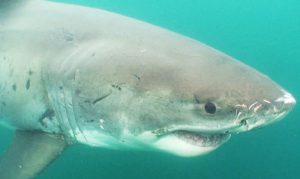
Photo: NOAA
Osmoregulation
It is worth bringing this up now. Osmoregulation is the control of the internal salt content in your blood and body fluids. Excessive salt can cause dehydration (loss of water – which is MUCH needed) and death. So, how does a fish living in saltwater deal with this problem?
You would think drinking seawater, but that would actually INCREASE your internal salt content and cause death faster. Note: if stranded at sea, do NOT drink seawater – will NOT help). So, what about those fish that live out there and have no option?
They have a system within their gills (and some fins) to extract salt from the seawater they drink. They actually “consume” freshwater AND they do not urinate as we do. Most of urine is water, and you do not want to lose any water if you live in the ocean. So, they don’t. Sharks take it a step further. They can actually excrete salts and minerals into their body fluids to increase the salinity and reduce the amount they diffuse into the ocean. Many fishermen will say “sharks pee in the meat” or urinate into their muscle. It is actually urea they are excreting. Urine is the combination of urea and water – it is not urine they are excreting. However, urea is not good so shark meat must be “bled” (as they say) before you eat it. You place the shark meat into freshwater and allow the blood and urea to diffuse out. Many fishermen will place the meat into a tub of freshwater for a few hours, then into another, and another, until the water remains clear – then you are good to go. Consuming shark meat is fine if it has been cleaned this way.
For those fish who do live in freshwater they have the opposite problem – they are not dehydrating but OVER hydrating. Water from the environment will diffuse into their cells. This water must be moved on by heavy urination and freshwater fish drink very little, if any, they do not need to – they are naturally absorbing it.
For fish like mullet that move back and forth – they can adjust their internal salt content to adjust to the external salt content – what we call euryhaline fish.

Image: Louisiana State University
Locomotion
As mentioned already, fish swim, and they do so by undulations of their fusiform bodies (those that have them) and fins.
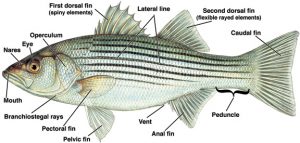
Image: University of Florida
Above is an illustration of a fish with the fins labeled. The dorsal and ventral fins (pelvic and anal) keep the fish from rotating like a bullet or football when moving forward at high speeds. Stability in other words. The pectoral fins are used for steering and the caudal fin is partly responsible for thrust (forward movement). Fins create surface area and surface creates drag at speed. So, faster fish have thinner, more streamlined angular fins. Many of the really fast fish will lack rays within their fins. Rays differ from spines in that they are split at the dorsal end, sort of like a “split hair”. They are softer and more flexible, and much better used in undulating and keep a fish steady when their swim bladders are partially inflated, and they are floating in the water column. Fast moving fish, like tuna, have no use for these.
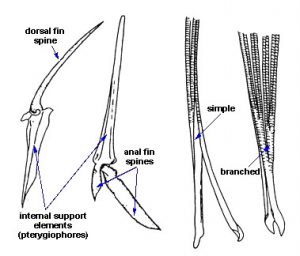
Image: University of Florida.
As mentioned, there are fish who used their spines to walk on the seafloor, flying fish use their enlarged pectoral fins to glide above the surface of the sea, and seahorses… well seahorses do what seahorses do. 😊 The fastest fish clocked was a sailfish at 68 mph. Many of the billfish are very fast and designed for it.
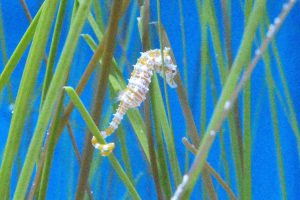
Predator-Prey
Fish eat and are eaten. With 30,000 species what they feed on varies greatly. Generally, fish whose mouths are towards the dorsal side of the head, reduce teeth, and enlarged gill rakers filter feed from the open water. Gill rakers are semi-flexible structures on the internal side of the gill that keep plankton from leaving the body via the gill slits, and rather force it down the gut.
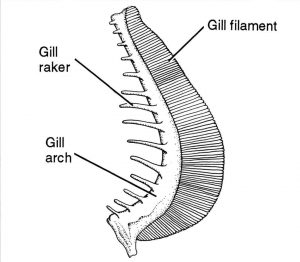
Image: University of Hawaii.
Fish with mouths facing ventrally generally feed from the bottom. Many will have molar like teeth for grinding and crushing shells, or sucker like mouths for vacuuming the bottom.
Fish with mouths at the terminal point of the head usually are carnivores. Many have sharp canine teeth for biting and cutting. Most fish lack molars as we know them so they select prey based on what they can swallow whole or cut into smaller bites.
There are many exceptions to the rules listed above. Sharks for example have mouth on the ventral side of the head but adjust the location when they open their mouths. They move into a more terminal position.
As far as predation… fish have plenty of predators. To defend themselves they use a variety of methods.
On the seafloor they can easily hide in and among the rocks and corals. Many are shaped and colored to mimic the environment they live in and many can change colors. Some burrow in the sand or hide in cavities. Clownfish live in associated sea anemones. They are immune to the venomous sting, but their predators are not, and so keeping their distance. Puffer fish can inflate and become “inedible”. And many benthic (bottom dwelling fish) are venomous. The venom is within their spines, which they expose when trouble approaches.
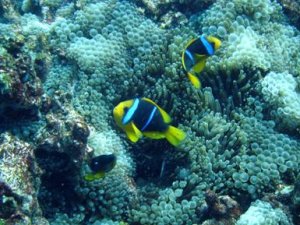
Photo: NOAA
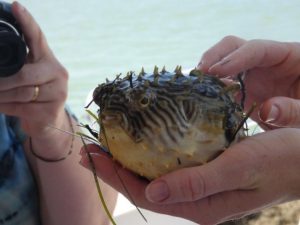
Photo: NOAA
Those fish who live in the open water column away from the bottom, like tuna and mackerel, must hide amongst themselves. Studies show that predators usually do not attack a group but rather follow the group waiting for one lone individual to make a break for it or try and force someone to break by quickly rushing the school. Many open water fish have what is called countershading. They are dark on top and light on bottom. This may be the help camouflage them in the open water. Dark blue on top blends in the dark blue below them. Likewise looking up at a fish above you, the white belly will blend in with the sunlit surface waters. There are other possible explanations for countershading, including temperature control.
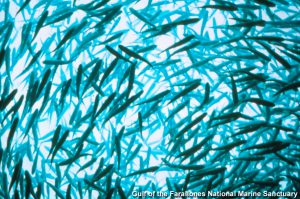
Photo: NOAA
Reproduction
As with everything else in the fish world, reproduction methods vary. In many species there are males and females. But in some the fish is male at birth becoming females later. In others it is the opposite. Some are active male and females at the same time.
Fertilization of the eggs is usually done externally. Female eggs, roe, are deposited on the seafloor, within a crevice, or in the water column. The male’s sperm, milt, is released over them. The fertilized eggs lack a hard shell (noncledoic) and are gelatinous. Development is usually in days, maybe weeks, and thousands, if not millions, of young fish, fry, are released into the environment. Most are consumed by predators very quickly.
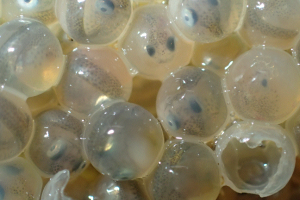
Photo: NOAA
To reduce this issue, some fish will spawn during an outgoing spring tide, or over long periods of time over large areas. Some fish collect their fertilized eggs and carry them within the parent. Male seahorses and catfish do this. The only way to consume these eggs is to consume the adults.
Some fish, many sharks for example, produce eggs but carry them within the body cavity giving “live birth”. These are called ovoviviparous – as opposed to oviparous (laying eggs outside of the body).
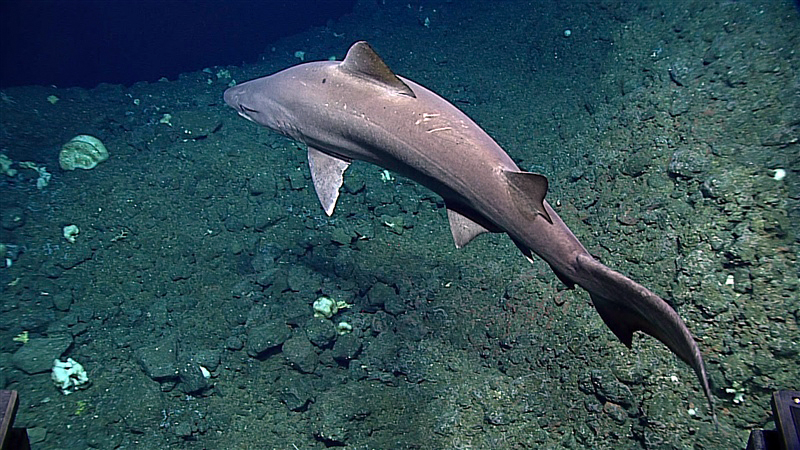
Photo: South Carolina Sea Grant
Many fish live very short lives, a couple of years, so they grow fast and produce a lot of offspring to assure their species continues. Others, some sharks, will live longer lives. With these fertilization and egg development is slower and not in the mass quantities we see other fish do.
THIS WAS A LONG LESSON, BUT HONESTLY, WE HAVE ONLY BEGUN TO SCRATCH THE SURFACE OF ICHTHYOLOGY. I ENCOURAGE YOU LEARN MORE ABOUT THESE AMAZING VERTEBRATES.
Activities
- Visit a public aquarium, or pet store, and see all of the variety of fish. All sorts of shapes and sizes. Ask questions about how they breed, what weird things you might learn about them. If your parents will allow… purchase a small tank and keep some fish as pets. Learn as much as you can about the species you select so that you can keep them healthy. Fish watching can be very relaxing.
- Visit a local seafood market to see what type of fish fishermen sell and what people are buying. For many this is as close as you can come to some of the larger species. If you want… try some! Purchase a fish you would like to try and have mom and dad cook you a good meal. Fish are part of a healthy diet. However, some species – mainly the larger predator species – can contain mercury and you should not eat more than 8oz./week. For young children or pregnant females, you should not eat any. You can find a list of such fish by visiting the website of Escambia County Division of Marine Resources or contacting your local Sea Grant Agent at the local County Extension Office.
- Go fishing. I mean this is fun. Many of you probably already do. BUT THIS TIME look at your fish a little closer before you release (or eat) it. What type of fins does it have? Where is the mouth located and what kind of teeth does it have?
- Design your own PERFECT FISH. Decide on what shape it should be – and why. Should it have fins? Why or why not? If it does have fins what shape should those be? Why? What type of senses does your fish have? How will it defend itself? And what color should it be? Last… what name are you going to give it? Have fun with this.
 0
0
